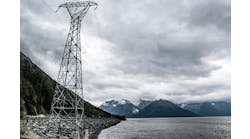Utilities without resilience strategies are taking a risk that jeopardizes their companies and customers, says a new report from Accenture.
By Elijah Lovkoff/Shutterstock.com
The report, “From Reliability to Resilience: Confronting the Challenges of Extreme Weather,” finds that most electric utility grid executives agree that extreme weather due to climate change poses challenges to their operations and profitability. Accenture collected data for the report from more than 200 utility executives from around the world as part of its 2020 global Digitally Enabled Grid research survey. The company conducted the survey between November 2019 and January 2020.
“Utilities cannot afford to wait — 92% of survey respondents thought that growing extreme weather events increase the financial risk level of network businesses, and 90% said they will increase the potential risk to the ongoing financial viability of the network business,” said the report.
The report identifies ways for utilities to become more resilient, including embracing distributed energy resources (DER) such as microgrids. It also addresses the need to put a price on resilience.
Among those who responded:
- 95% said that distributed generation is a long-term solution for increasing resilience
- 93% see “self-islanding solutions” as an important way to boost resilience over the long term
- 90% said that an increase in extreme weather poses a risk to the financial viability of their electricity network businesses
- 88% hold that maintaining network resilience will lead to “significant” increases in network prices for customers
It’s important to educate customers and other stakeholders about the importance of resilience because they’ll likely think it’s expensive, said the report.
“An effective resilience strategy persuades stakeholders — from regulators to customers — that developing and maintaining the necessary capabilities to handle such events is worth significant upfront, ongoing costs,” said the report.
Invest in system flexibility…DERs, microgrids
One important way to create resilience is by focusing on system flexibility, which includes investing in DERs, microgrids and customer participation to reduce the impacts of extreme weather.
Self-islanding solutions will be important tools for boosting resilience. And solar plus storage and electric vehicles (EVs) can serve as emergency electricity sources and help electrify community disaster centers during outages, said the report.
Quantifying the value of resilience is a major challenge, the report said. The authors noted that there’s no standard definition of resilience among utilities or regulators.
“And what is the value of that resilience? How can the societal value of resilience be measured and quantified to inform a business case for investment in resilience?” asked the report authors.
Most utilities have experience estimating the value of customers’ load lost during short outages. They usually use these estimates to establish regulatory targets for reliability.
But those estimates miss a larger, important advantage of resilience: the benefits to society.
“The societal value of electricity should include social, health, wider economy, safety, environmental and financial risks. For example, the impact to the reputation and economics of long-term outages on cities, disruption of global supply chains and increased pollution from alternative energy sources.”
Resilience efforts that spur higher network costs could hurt relationships with customers and regulators, if the activities don’t lead to service performance.
“A persuasive resilience strategy will include incentives, metrics and modeling. These will form the basis for a collaborative approach between regulators and the utilities. The expenditure requirements needed to increase resilience require regulatory assistance,” said the report.
Make way for innovation
“The general paucity of regulatory direction on resilience gives network utilities an opportunity to take the lead…”
To execute a strategy, utilities should focus on establishing the foundations of resilience, building a network that supports resilience and making way for innovation that will spur resilience, said the report.
“The general paucity of regulatory direction on resilience gives network utilities an opportunity to take the lead, not only on defining what resilience is, but also on how it should be monitored and assessed,” said the report. What’s more, utilities need to move quickly; 90% of survey respondents said that extreme weather events will increase the risk to the financial viability of network businesses.
Courtesy of Accenture
How utilities can incorporate resilience strategies
“Resilience is not necessarily a single solution…”
How can they proceed? Focus on resilience in corporate vision and business plans. Assign responsibility for resilience and develop ways to gather data about weather and the potential for fires, said the report.
Utilities also can take action by re-evaluating their smart grid initiatives, and incorporating a resilience focus. Many distribution utilities have had a hard time scaling smart grid pilot projects. That’s due partially to challenges communicating the business case for transitioning from traditional solutions to digital-based ones, said the report.
“Resilience is not necessarily a single solution for all smart grid business cases, but it does potentially form a considerable addition to the potential value in some cases,” said the report.
Regulatory assistance will be needed to help pay for resilience measures, and a collaborative approach between regulators and utilities is key.
The report concludes with clear advice for utilities. “Start now by considering the big picture. Use the three elements of resilience — the foundations, the network and emerging solutions — to map out and execute your own resilience strategy. Supporting resilience more directly must become a significant part of the utility’s growth trajectory,” said Accenture’s report.
Track news about resilience strategies. Subscribe to the free Microgrid Knowledge Newsletter.








